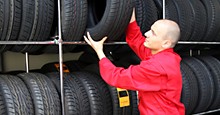
Tires are easy to forget until they go flat or your vehicle slides into a stop when you push the brake pedal.
How does tread design affect your driving and safety? And what kind of tread should you use for your driving environment?
"A tire is a complex composite structure with fabric and steel components,” said Jim Davis, spokesperson for The Goodyear Tire & Rubber Co. “There are countless variations as these many components are tweaked, depending upon the intended performance features to emphasize in each product.”
Tires are one of the hardest working integral parts of your vehicle. They must support heavy loads under extreme conditions such as heat, cold, sudden braking, cornering—while providing a smooth, quiet ride.
“All of this has to happen in many different weather conditions, temperatures, loads, speeds and on a variety of road surfaces,” Davis said. “Tire manufacturers have to balance product design with a ‘performance triangle’—rolling resistance, tread wear and traction.”
Increasing one aspect of the performance triangle can affect the other two.
“It is a constant tradeoff to expand the triangle and minimize design compromises,” Davis said.
What does that mean for drivers?
Choosing the right tire for your car and driving conditions is paramount. Drivers who live in extreme cold climates may want “winter tires” with tread that contains traction grooves for better grip on snowy roads and rubber that remains somewhat pliable in freezing temperatures.
Drivers in temperate climates can use “all weather” tires that have tread patterns for rain yet offer a smooth ride. All weather tires have tread that tends to last longer than the soft rubber compounds found in winter tires.
Tire tread often shows “siping,” small slits that help improve traction and handling. Some service centers offer tire siping services, but altering the tire could void its warranty and reduce tread life.
"Tread design dramatically influences the way your vehicle performs in different environments,” Davis said. “For instance, increasing how much rubber touches the road can help determine the level of grip the tires provide for a vehicle. Additionally, tread designs and rubber compounds can affect fuel economy.”
Davis offered the following advice for drivers looking to purchase the right tire to meet their specific environment and driving habits:
Do you travel often in the snow? Look for tires with tread design that provides good traction on snow and ice-covered roads.
Live in a mild climate? Consider a general “all weather” tire designed for long tread life and comfortable riding.
Tire tread design influences fuel economy. For passenger vehicles, fuel-efficient tires can boost a vehicle's fuel economy by 5% or more.
Drivers of high performance or sports cars should consider tires with race-inspired tread compounds and innovative tread designs, good enough to handle a day at the track.
Whatever vehicle is being driven--from a work truck to an exotic sports car--remember the importance of proper tire pressure. Properly inflated tires will benefit the vehicle's performance, provide even wearing tires for longer tread life, and help improve fuel efficiency.
Copyright © 2024 by Sensible Driver. All rights reserved.